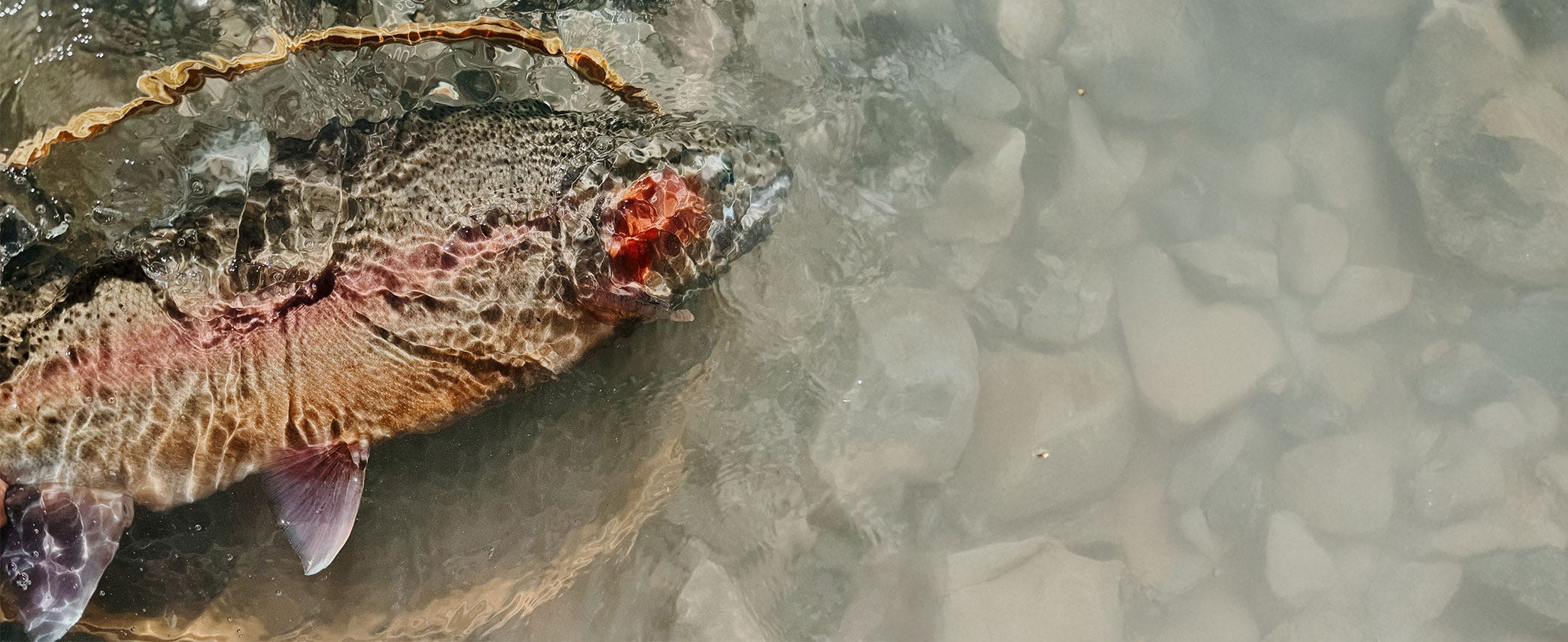Ice Out Trout On Montana's Rocky Mountain Front

Words by Fred Telleen
THE CLOCKS HAVE COMPLETED THEIR SPRING FORWARD. COLD SNAPS ARE GETTING SHORTER.
Chinook winds have carved away the ice and snow. Warm days are sprinkled into the coming weeks. It is ice out time again, and it’s hard to pass up the springtime urge to tangle with some large, hungry trout.
Wild river fish are beginning to spawn, too, and in certain areas should be left alone. Lakes hold much larger trout than streams and rivers do anyway, and while these planted trout will mature and want to spawn, they do not do so successfully. So, you don’t have to worry about harassing them—their futures are assured by the state stocking program and, in some cases, natural spawning. So, if you’re looking to get out, late March into early May is a great time to focus on the reservoirs of the Missouri River system, and along the Rocky Mountain front.
As the ice initially breaks up, oxygen pumps into the water and the shallows quickly warm by a few degrees. Fish metabolism spikes along with their need to eat. For four-to six weeks, trout roam the shorelines where the water is warmer and the food most prevalent. This makes it easy for shoreline angling with a fly rod. Not only are they easy to reach with an average length cast, but they are often easy to spot, allowing for exciting sight-fishing.


THE BALANCED LEECH
So, you found them roaming a shoreline. Now, what are you going to give them? Think about it. Big hungry fish. Little to no insect activity. Did I say, big, hungry fish? Give them something big enough to chew on. Feed them a Balanced Leech on a #6 or #8 jig hook. That’s what I usually start with. Trout cruising the shorelines will often run 3 to 5-feet deep, and suspending a Balanced Leech under an indicator allows you to keep your fly in their traveling lanes and right where they will find it. A bit of wave action is ideal for this technique. In fact, windy wavy conditions are often the best. I always tie my Balanced Leech on with a loop knot, allowing it to constantly appear to be swimming horizontally as the indicator lifts it up and down with the waves. Big, cruising fish generally find this very hard to pass up. At times, the action can be non-stop for hours.
CHIRONOMIDS
Chironomids are large stillwater midges, and they begin hatching immediately after the ice goes out. Their numbers build as the waters warm. The best time to fish the Chironomid is when the water is relatively calm, or even completely glassed out. At times, you will even see fish breaking the surface as they follow emerging larvae to the top. Later in summer, fishing these midges often requires long leaders with the flies suspended near bottom. During the ice-out window, hanging a chironomid 3 to 5-feet under and indicator puts it right in the traveling lanes where fish will eat them.
THE WORM
While I don’t believe there are a bunch of red worms roaming below the surface in the spring, the trout don’t seem to worry about this. There are times when hanging a good old red San Juan Worm below your indicator gets attention. Also, purple. Just saying.




MINNOWS & CRAYFISH
As the waters warm for weeks after the ice is gone, minnows and crayfish come into play. Stripping streamers that imitate small trout, sticklebacks, sculpin and crayfish often tempts the largest predatory trout. You can also throw in big buggers that imitate fish or leeches in equal measure. These larger flies fish well on a sink-tip, but when fish are still shallow, a floating line can get it done.
FLY DELIVERY SYSTEMS
Shoreline ice-out fishing is perfectly suited for 9-foot long trout rods in 5-7 weight with standard tapered leaders from 1X to 3X. If you want to specialize, longer rods are a great option. During calm conditions, casting and retrieving flies with a 9-foot rod is great. But, I typically use a 10-foot 6-weight rod with a 7-weight line for most of my indicator fishing. At times, I will also opt for a 3 or 4-weight 11-foot trout spey rod with a #8 weight-forward line. The longer, with two-handed casting leverage, has made for great windy day sport when most anglers have left the water. The spey rod also makes for easy roll-casting when fishing along bluffs, or any time backcasting room is limited.


GO TIME: ICE OUT IS EASY
One of the best things about ice-out fishing is it can be very uncomplicated. First, you don’t need a boat. Which means you won’t need a shuttle. A few Balanced Leeches in a variety of colors, a few chironomids, a handful of nymphs, some tippet and a couple indicators and you are squarely in the game. If you want to be more prepared, pre-rig several rods, put them in your vehicle, and have them ready to go. You will likely be driving close to the water where you will have easy access to your vehicle and can switch out tackle as conditions or fish moods change. Bring along a cooler and a camp chair. You will likely enjoy a beer and a snack while you take in the views and the sounds of the lapping water and possibly a flock of snow geese or swans. And doing just that means you’ve probably just landed your biggest trout of the year.
